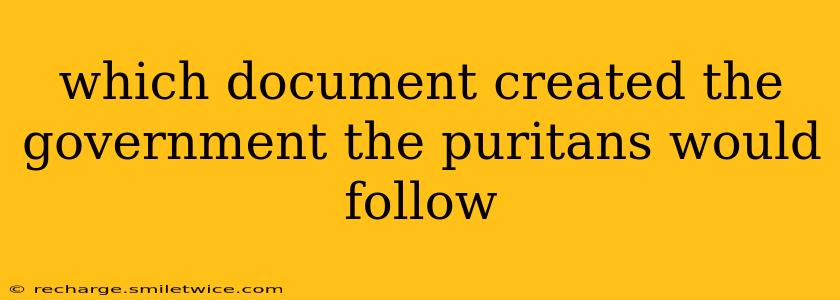The Mayflower Compact: The Foundation of Puritan Governance
The document that established the framework of government for the Pilgrims, a group of Puritans who landed at Plymouth Rock in 1620, was the Mayflower Compact. It wasn't a formal constitution in the modern sense, but it served as a crucial agreement for self-governance in the absence of established English authority. Understanding its context and implications is vital to grasping the early history of New England and the development of Puritan society.
This agreement, signed aboard the Mayflower before the settlers even set foot on land, wasn't imposed by a distant king or parliament. Instead, it represented a crucial moment of self-determination and civic responsibility, laying the groundwork for future governing structures.
What did the Mayflower Compact actually do?
The Mayflower Compact wasn't a detailed blueprint for a government, but rather a social contract. It established a civil body politic, binding the signatories to create just and equal laws for the general good of the colony. This was a remarkably progressive concept at the time, highlighting the Pilgrims' commitment to collective decision-making and self-governance, even in the face of potential disagreements. Essentially, they agreed to abide by the laws they themselves would create.
The core tenets of the Compact were:
- Consent of the Governed: The signatories consented to be governed by the laws they agreed upon. This principle would later become fundamental to American political thought.
- Civil Body Politic: It established a formal government, albeit a rudimentary one, in an area where English law didn't fully extend.
- Just and Equal Laws: The aim was to create laws that were fair and applied equally to all members of the colony.
What type of government did the Mayflower Compact create?
The Mayflower Compact established a form of direct democracy, although a very basic one. There wasn't a sophisticated system of checks and balances, or a clearly defined separation of powers. The signatories essentially agreed to obey rules made by a governing body chosen amongst themselves. It's important to note that the Pilgrims were not fully democratic in the modern sense; many members of the community, including women and enslaved people, were excluded from participation in this governance.
Over time, this system evolved, leading to the establishment of more formal governing structures in Plymouth and other Puritan settlements. The Compact itself didn't specify the exact form of government, but it laid the foundation for future political development.
How did the Mayflower Compact influence later governments?
The Mayflower Compact's significance extends far beyond its immediate impact on the Plymouth Colony. It served as an important precedent for later colonial governments, demonstrating the concept of a social contract and the right of the people to self-govern. Its emphasis on consent, laws for the common good, and establishing a civil body politic deeply influenced the development of American political thought and the principles enshrined in the later Declaration of Independence and the Constitution.
Was the Mayflower Compact truly a Puritan document?
While often associated with the Puritans, it’s crucial to remember that the Pilgrims who signed the Mayflower Compact were separatist Puritans—a distinct group. They had separated from the Church of England, seeking greater religious freedom than the generally more moderate Puritans who stayed within the Church, albeit seeking reforms. While the Pilgrims' faith undoubtedly influenced their commitment to community and self-governance, the Compact itself doesn't explicitly lay out a system of religious governance. Their religious beliefs certainly informed their approach to social order, but the Compact focused on the creation of a civil society.
Did the Mayflower Compact have any limitations?
The Mayflower Compact, while significant, had inherent limitations. Its democracy was limited in scope, excluding many from participating. Furthermore, it lacked the detailed structure and checks and balances that characterize later constitutions. Its brevity also means it didn’t directly address many critical issues of governance. Yet, its historical significance remains undeniable as a crucial early example of self-governance in America and a stepping stone towards the development of more complex political systems.
